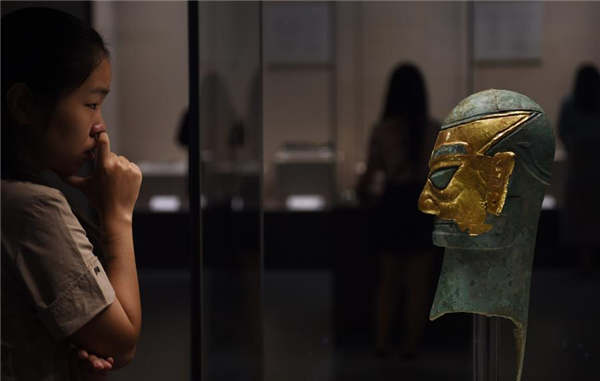
Prehistoric artifacts are on display at the show Mystery of Sanxingdui, which is running at Changsha Museum through December. (Photo/Xinhua)
The Chinese are increasingly exploring cultural relics as a part of their daily lives.
No matter which city Ai Xiaoyang visits, museums always top her list of must-see places to know more about the local history and culture.
With Chinese museums showing their creativity in recent years, this veteran museum visitor from Beijing has had a good time.
"Museums are no longer isolated," says the 28-year-old.
"Their abundant souvenirs, interactive facilities and lectures make it easier to learn about the exhibits."
She has downloaded a few phone apps of the Palace Museum in Beijing to get her daily dose of the museum's collections and know about upcoming exhibitions. She has also bought many souvenirs from online stores as gifts for friends.
In mid-September in Chengdu, capital of Southwest China's Sichuan province, 6,000 souvenirs offered by the Palace Museum were sold out within a day at the 7th Chinese Museums and Relevant Products and Technologies Expo.
More Chinese are seeing museums as a part of their daily lives.
"China is the country with the fastest growth in museums," Duan Yong, director of the museum department of the State Administration of Cultural Heritage, said during the expo.
"The country is marching to become a strong power in terms of museums, but there's still much to be done."
According to Duan, there were 4,692 registered museums on the Chinese mainland by the end of 2015, with the industry employing some 90,000 people. About 20,000 exhibitions were staged in the country's museums last year, attracting 700 million visitors. About 85 percent of the museums are open to the public for free.
"Most museums have realized that they are seen as institutions of academic research and education and not just exhibition venues," says Duan. "But the development of museums is not balanced in China."
According to him, there are some 1,000 counties, mostly in western China, that still have no museums.
"In spite of the fast growth, our focus needs to be switched to more specialized and grassroots museums," he says.
"And the sharing of resources among different museums will become a trend. It will be the way to enhance communication and make full use of collections."
For example, Henan Museum in Zhengzhou, capital of Central China's Henan province, has been promoting public education about museums in poverty-stricken regions not only in the province but also in western China.
"Museums are now more than custodians of cultural relics," Tian Kai, director of Henan Museum, explains.
"They have to cooperate with different cultural institutions to allow more people to enjoy their resources."


















































